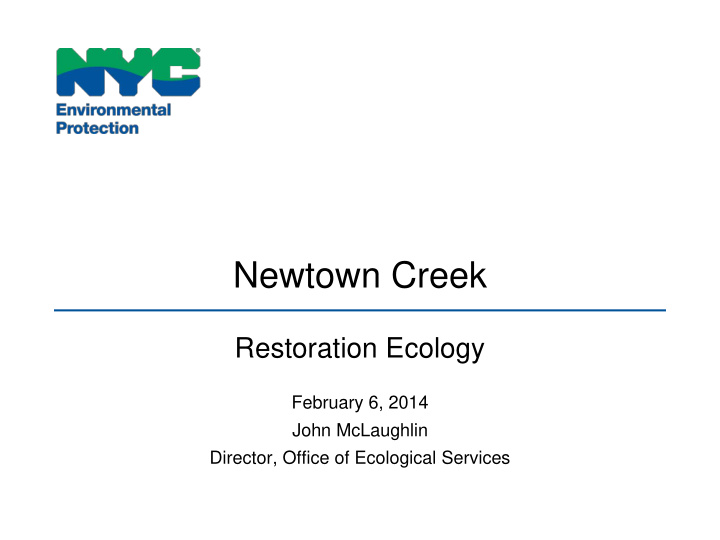



Newtown Creek Restoration Ecology February 6, 2014 John McLaughlin Director, Office of Ecological Services
Office of Ecological Services Mission Statement Statement • To protect and improve the ecological integrity of NYC ecosystems by developing and implementing innovative, sustainable environmental restoration practices, providing science based recommendations to DEP and other stakeholder groups to eliminate or minimize potential disturbance impacts on the environment. • How do we do that? “ Ecological Restoration is the process of assisting the recovery of an ecosystem that has been degraded, damaged, or destroyed. It is the practice of restoring ecosystems as performed by practitioners at a specific site.” “ Restoration Ecology is the science upon which the practice is based. Provides the knowledge, methodologies and the tools for practitioners in support of their practice.” 2
New York-New Jersey Harbor Estuary Wetlands Green Shading represents shoreline of New York City and surrounding areas in late 1800’s – system has been drastically altered. Approximately 85% of all tidal wetlands have been lost in NYC – fragmented ecosystem except in limited locations (i.e., Jamaica Bay – where approximately 1,200- acres remain of the original 16,000-acres. 3
Newtown Creek Historic Wetland Coverage Historically, there were approximately 1,200-acres of tidal wetland along the banks of Newtown Creek – today there are zero – representing a 100% loss of tidal wetland habitat and associated functions. 4
Typical Sinuous Stream Credit: USDA 5
Newtown Creek Morphology • Historically, Newtown Creek was approximately 12’ in depth o Today it is dredged to a depth of 23’ in main channel and 20’ in turning basins. • Change in tidal prism o Head end of creek was historically shallower to allow for greater tidal flushing. • Riparian Buffers o Vegetated watershed buffer controlled “pulses” to creek. 6
Impervious Cover and Stream Health Credit; CWP 7
Impervious Cover and Stream Health Hydrologic Cycle has changed… Impervious surfaces cover 72% of NYC’s land area 8
Development of Target Ecosystem Characteristics • It’s not all bad and conditions can be improved – by using research institutions for guidance on restoring urban ecosystems • Important Points to Consider: o Ecosystem is human dominated and will remain a human shaped landscape. o Ecosystem has been irreversibly changed in almost all its properties. o Ecosystem is dynamic and will change further in time. o Science and technology can make clear and valuable enhancements. 9
Ecological Improvements to Newtown Creek • Living Shorelines o "Living shorelines are the result of applying erosion control measures that include a suite of techniques which can be used to minimize coastal erosion and maintain coastal process. Techniques may include the use of fiber coir logs, sills, groins, breakwaters or other natural components used in combination with sand, other natural materials and/or marsh plantings. These techniques are used to protect, restore, enhance or create natural shoreline habitat." Credit: Chesapeake Bay Foundation 10
Ecological Improvements (e.g., Alley Creek) • Fill removal to create wetlands from existing uplands • Potential turning basin “filling” to create tidal wetlands and increase tidal flushing • Where there are no water dependent uses • Vegetative buffers to treat run-off • 20’ Vegetated Buffer on existing properties 11
Terraced Bulkhead Example Rendering Credit, AECOM, Environment 12
Recommend
More recommend